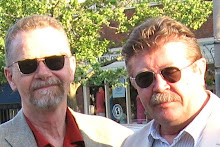
DANCE THEATRE REVIEW: ORPHEUS AND EURYDICE
2 NOV/11
JOHN COULBOURN - QMI Agency
R: 4/5
Pictured: Dorotea Saykaly
TORONTO - For most of us, the story of ORPHEUS AND EURYDICE is a familiar one, thanks in no small part to the resonance the Grecian myth has consistently found in the artistic world. Based on the number of operas, ballets and plays it has spawned, the story of Orpheus’ love for the beautiful but ill-fated wood nymph Eurydice has never had a chance to grow old. There’s just something it seems about a love so strong it could compel Orpheus to follow the love of his life to hell after she has been bitten by a poisonous snake, and allow him to charm death itself with his music to reclaim her, only to lose her to his own impatience.
But chances are, no matter how many times you’ve seen or heard the story told, you’ve never seen it — or heard it — in quite the same way as it is presented in the latest version to grace a Toronto stage. It’s the handiwork of Quebec dancer/choreographer Marie Chouinard, who created it on her own company back in 2008 for Italy’s Festival Equilibrio — and it opened a very limited run (through Saturday) at the Bluma Appel Theatre, a presentation of Canadian Stage.
For openers, Chouinard doesn’t concentrate solely on the tragedy of the story as we know it, using it instead to explore deeper themes of love and communication by focusing on Orpheus’ posthumous role as inspiration to the poets of Lesbos. In fact, the tragedy which sits at the heart of the story is presented finally as a bit of high-camp send up, with the entire corps of 10 dancers — five male and five female — playing the story’s protagonists in an ever-shifting panorama.
Costumed in the most basic way by VANDAL — both men and women dance naked from the waist up, save for gold pasties that cover their nipples — they seem to suggest that, under all that skin, there is a little bit of ORPHEUS AND EURYDICE in all of us. It’s a feeling reinforced by a choreographic style that manages to feel totally contemporary even while it echoes of ancient Grecian and Etruscan friezes.
While Chouinard and her company make mythological magic by evoking the satyr that drove Eurydice to her death by strapping rampant prosthetic phalluses to the males in the corps and dancing largely in silhouette, the ancient charm is quite literally underscored by the kinky modernity of the platform stilettos that complete the dancers’ wardrobe.
Then there’s the score, created in large part from found and ambient sound, blended with the dancer’s own, often primal voices. It works in tandem with Chouinard’s often sexually charged choreography to examine mankind’s urgent struggle to communicate in every way — from the sexual to the poetic. And while it may be a struggle as old as time itself, it’s a struggle exacerbated in a modern world where even the texts of Giorgio Agamben’s Profanations are all but drowned out by the chatter around it.
It’s strange, heady stuff, often outrageous and witty and always unabashedly sexual — a work that plays with its audience even while it works hard to push the boundaries of human communication and understanding without stooping to do much that remotely resembles linear storytelling. And while it’s easy to embrace it in its entirety, pared as it is to a single act of just over an hour’s duration, for this viewer, at least, the one thing missing in what purports to be a work about the world’s first poet is a sense of that poetry in the motion.



No comments:
Post a Comment